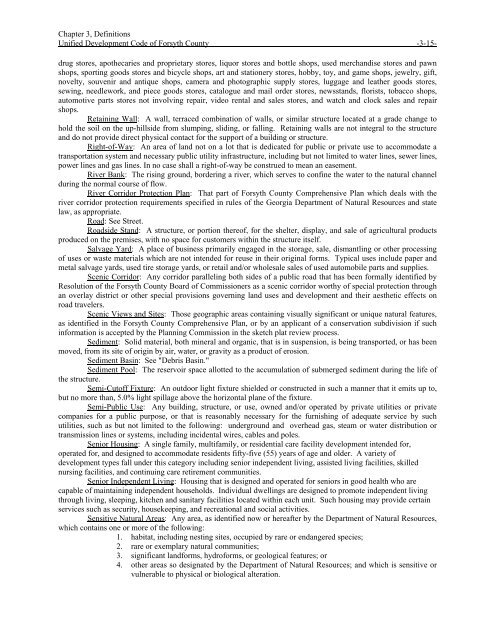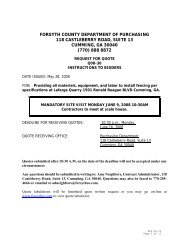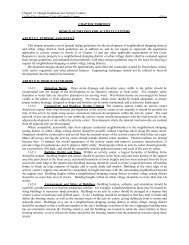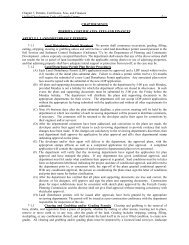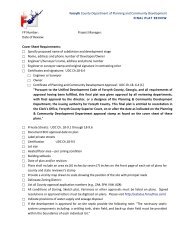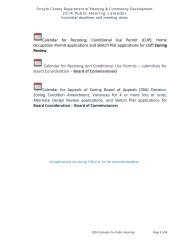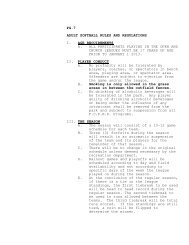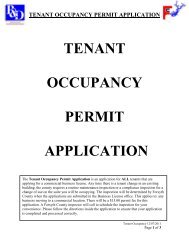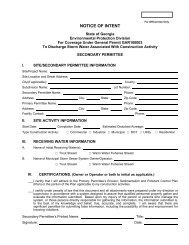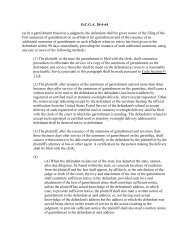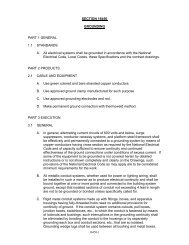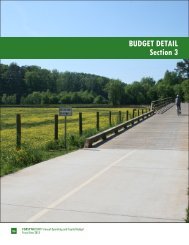Complete UDC - Forsyth County Government
Complete UDC - Forsyth County Government
Complete UDC - Forsyth County Government
Create successful ePaper yourself
Turn your PDF publications into a flip-book with our unique Google optimized e-Paper software.
Chapter 3, Definitions<br />
Unified Development Code of <strong>Forsyth</strong> <strong>County</strong> -3-15-<br />
drug stores, apothecaries and proprietary stores, liquor stores and bottle shops, used merchandise stores and pawn<br />
shops, sporting goods stores and bicycle shops, art and stationery stores, hobby, toy, and game shops, jewelry, gift,<br />
novelty, souvenir and antique shops, camera and photographic supply stores, luggage and leather goods stores,<br />
sewing, needlework, and piece goods stores, catalogue and mail order stores, newsstands, florists, tobacco shops,<br />
automotive parts stores not involving repair, video rental and sales stores, and watch and clock sales and repair<br />
shops.<br />
Retaining Wall: A wall, terraced combination of walls, or similar structure located at a grade change to<br />
hold the soil on the up-hillside from slumping, sliding, or falling. Retaining walls are not integral to the structure<br />
and do not provide direct physical contact for the support of a building or structure.<br />
Right-of-Way: An area of land not on a lot that is dedicated for public or private use to accommodate a<br />
transportation system and necessary public utility infrastructure, including but not limited to water lines, sewer lines,<br />
power lines and gas lines. In no case shall a right-of-way be construed to mean an easement.<br />
River Bank: The rising ground, bordering a river, which serves to confine the water to the natural channel<br />
during the normal course of flow.<br />
River Corridor Protection Plan: That part of <strong>Forsyth</strong> <strong>County</strong> Comprehensive Plan which deals with the<br />
river corridor protection requirements specified in rules of the Georgia Department of Natural Resources and state<br />
law, as appropriate.<br />
Road: See Street.<br />
Roadside Stand: A structure, or portion thereof, for the shelter, display, and sale of agricultural products<br />
produced on the premises, with no space for customers within the structure itself.<br />
Salvage Yard: A place of business primarily engaged in the storage, sale, dismantling or other processing<br />
of uses or waste materials which are not intended for reuse in their original forms. Typical uses include paper and<br />
metal salvage yards, used tire storage yards, or retail and/or wholesale sales of used automobile parts and supplies.<br />
Scenic Corridor: Any corridor paralleling both sides of a public road that has been formally identified by<br />
Resolution of the <strong>Forsyth</strong> <strong>County</strong> Board of Commissioners as a scenic corridor worthy of special protection through<br />
an overlay district or other special provisions governing land uses and development and their aesthetic effects on<br />
road travelers.<br />
Scenic Views and Sites: Those geographic areas containing visually significant or unique natural features,<br />
as identified in the <strong>Forsyth</strong> <strong>County</strong> Comprehensive Plan, or by an applicant of a conservation subdivision if such<br />
information is accepted by the Planning Commission in the sketch plat review process.<br />
Sediment: Solid material, both mineral and organic, that is in suspension, is being transported, or has been<br />
moved, from its site of origin by air, water, or gravity as a product of erosion.<br />
Sediment Basin: See "Debris Basin."<br />
Sediment Pool: The reservoir space allotted to the accumulation of submerged sediment during the life of<br />
the structure.<br />
Semi-Cutoff Fixture: An outdoor light fixture shielded or constructed in such a manner that it emits up to,<br />
but no more than, 5.0% light spillage above the horizontal plane of the fixture.<br />
Semi-Public Use: Any building, structure, or use, owned and/or operated by private utilities or private<br />
companies for a public purpose, or that is reasonably necessary for the furnishing of adequate service by such<br />
utilities, such as but not limited to the following: underground and overhead gas, steam or water distribution or<br />
transmission lines or systems, including incidental wires, cables and poles.<br />
Senior Housing: A single family, multifamily, or residential care facility development intended for,<br />
operated for, and designed to accommodate residents fifty-five (55) years of age and older. A variety of<br />
development types fall under this category including senior independent living, assisted living facilities, skilled<br />
nursing facilities, and continuing care retirement communities.<br />
Senior Independent Living: Housing that is designed and operated for seniors in good health who are<br />
capable of maintaining independent households. Individual dwellings are designed to promote independent living<br />
through living, sleeping, kitchen and sanitary facilities located within each unit. Such housing may provide certain<br />
services such as security, housekeeping, and recreational and social activities.<br />
Sensitive Natural Areas: Any area, as identified now or hereafter by the Department of Natural Resources,<br />
which contains one or more of the following:<br />
1. habitat, including nesting sites, occupied by rare or endangered species;<br />
2. rare or exemplary natural communities;<br />
3. significant landforms, hydroforms, or geological features; or<br />
4. other areas so designated by the Department of Natural Resources; and which is sensitive or<br />
vulnerable to physical or biological alteration.


